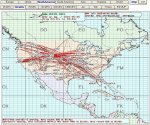The earth return angles of radiation is quite apparent on 50mhz, and while F-level skip signals arrive very low, if is a different matter for E refraction. For communications other than line-of-sight, a low quarter wave antenna is often superior to a high mounted antenna, and this is especially evident if you look at the radiation patterns of such antennas v.s the arrival angles of DX signals.
--- A practical observation of this is where I live. I am surrounded by 13- to-14,000 foot mountains to the North and West rising over 11-12 degrees, and to the East by 8-9 - from the horizon. The majority of F layer 50 mhz DX signals would, and I say "would" but they can't --- arrive but for those mountains- at angles between 3 and 9 degrees above the horizon.... thus I live in what is a radio 'black hole' for this type of skip. E layer is something else, since E skip arrives at much higher angles. In the summer 600 to 1000 mile DX is common- but nothing further unless it is double-hop. Since the signals get scrambled in transit, horizonal v.s vertical polarization doesn't seem to matter- both are effective. And since E-skip is so effective with QRP, I use only 20 watts to a 5/8 wave vertical on 50 mhz, and it works for me just as well as a beam and QRO.
The science of propagation is fascinating, and an adherence to physics will pay dividends in understanding how all this works (might I suggest a nice place to start?- the ARRL Antenna Book.)
Hmmmmm--- well, understanding this it is nice, but it doesn't get signals through mountain ranges.....

.................................CF


